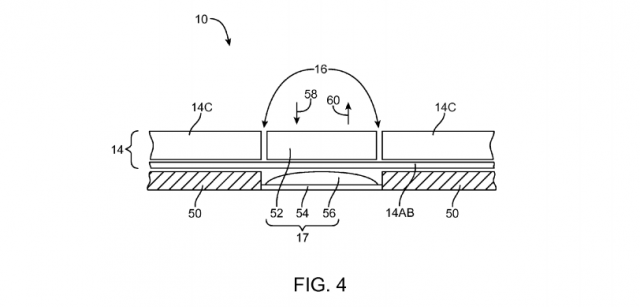Apple has been awarded a new patent by the U.S. Patent and Trademark Office, for `Electronic devices with flexible displays’, which controls mechanisms used with flexible displays to replace components like physical buttons with additional durable as well as resilient alternatives, to create another means of detecting sound output with haptic feedback, which is sound and localized vibration and perform other things thus making it easier to open a MacBook lid.
The patent describes several options to use a flexible display for a variety of input methods aiming at ways that can put flexible display material over actuators in order to create new buttons on demand.
Besides this it also provides systems to overlay them on the existing button features that are found in the iPhone such as the Home button, thus providing access to it while simultaneously protecting it as well as providing a continuous surface for the individual.
The system combines flexible display layer in some embodiments, like a compatible OLED substrate with a similar flexible capacitive touchscreen layer which then is covered by a rigid or a flexible cover.
Assembly Flexible – Interacting with Components
Since the assembly is flexible, users have the opportunity of interacting with components that are installed beneath it which serve as a user input and when force is used, the display activates and deforms the internal button, other sensor or dome switch before returning to its original shape.
Moreover, the internal actuators could be used to press against the flexible layer upwards to create temporary ridges, points or shapes on the surface of the display wherein each region could be active or inactive to user input. Ridges for instance could be used to outline grid pattern matching the onscreen keyboard.
According to an example, control structures or buttons get input from user’s finger or object that are pushed on the display, thereby deforming and transferring force on a sensor and some system tend to extend the device’s active screen area by replacing the external control as in the case of iPhone’s home button with internal counterparts.
Benefit of Flexible Display
There is another benefit in using the flexible display on top of the button and switch wherein it enables Apple to potentially expand screen space with the possibility to build all display devices which can grow or reveal buttons whenever needed. They can also take the form of physical buttons, as created by actuators that are used beneath the display layer to push up on the screen, creating bumps and ridges.
Its effect would be similar to what happens with the Tactus keyboard that produces a physical keyboard from a transparent, flat display cover. As the overall patent is aimed at devices such as the iPhone and iPad and its intention is to save space on mobile devices, there is a provision which explains how the tech could be utilised in a MacBooktrack pad in order to deform the surface and raise the top of the notebook away from the bottom thus making it a lot easier to open, preferably creating a lid opening which may replace the groove that is available in current models.




